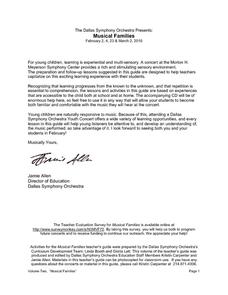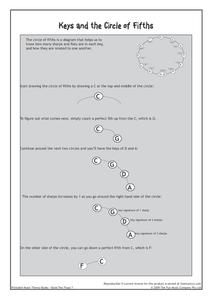Curated OER
Outline: Notes of the Treble Clef Staff
Score one for test prep. Young musicians are encouraged to create their own mnemonic devices to prepare themselves for a test on the treble clef staff. Using the provided worksheet, individuals record, in order, the names of the lines...
Dallas Symphony Orchestra
Musical Families
Planning a trip to the symphony? Prepare first-time attendees for the experience with overheads that identify the roles played by the concertmaster, conductor, musicians, and even the audience. The musical families are introduced and...
WHB Elementary School Band
Circle of Fifths: Major Keys
How many sharps and flats are their in each of the major keys? Help keep your young musicians sharp with a printable template that models how to identify the signature for the major keys' sharps and flats.
Fun Music Company
Note Values
Note values are the focus of a short worksheet that asks young musicians to respond to short-answer questions and to complete a measure with notes of the appropriate value.
Fun Music Company
Compound Time
To demonstrate their understanding of simple and compound time signatures, young musicians complete a chart by drawing quarter or dotted quarter notes equal in value to the note groups shown.
Fun Music Company
Intervals
As part of their study of intervals, musicians are asked to draw the interval indicated above the notes provided on the worksheet.
Fun Music Company
Transposition
Up a perfect fifth, down an octave. Transposing a piece to suit the range of singers, and instrumentalists, is a key skill musicians must perfect. This worksheet explains how to transpose and gives learners a change to practice.
Fun Music Company
Working Out the Key
"Gimme an E minor!" Or any key for that matter. But how do you figure out the key of a piece of music? Here's a worksheet that shows young musicians three easy steps to help them identify the key of a piece of music.
Fun Music Company
Classification of Intervals
Major 2nd, Perfect 4th, Minor 3rd. The number and classification of intervals are the focus of a one-page worksheet that asks musicians to write the intervals above given notes and to indicate the classification of others.
Fun Music Company
Writing Major Scales
Designed as an assessment of understanding, this one-page learning exercise asks musicians to demonstrate their understanding of scales by drawing C, G, and F Major scales on the provided staffs.
Fun Music Company
Musical Terms for the Digital Age
Young musicians must unscramble music expressions and then use the key pad from a digital keyboard to answer a music trivia question.
Fun Music Company
The C Major Scale
Your young musicians will take note of this worksheet that asks them to mark the half steps in a C major scale and then write the scale in both treble and bass clef.
Fun Music Company
The Treble Clef
Gee, your young musicians should have no trouble tracing the treble clefs on this worksheet. Once they have mastered this tricky signature, they place it correctly on a staff.
Fun Music Company
Keys and Circle of Fifths
How sharp are your young musicians? Can they perfectly identify the sharps and flats in each key by completing a circle of fifths diagram? There is solid theory behind this exercise.
Fun Music Company
Treasure Island Clues
In order to answer a music trivia question, young musicians must count the number of ties in a melody, name the final note, and use these clues to spell out Charlie Parker's nickname. This activity is not for the birds.
Fun Music Company
Treasure Island Clues: Scales
Which Beatle received the most fan mail? To answer this music trivia question, young musicians must employ their knowledge of scales, key signatures, and leading notes to find the letters that spell out the name of one of the famous mop...
Fun Music Company
Treasure Island Clues: Rhythm
Designed for rhythm level 1, the two games in this packet ask young musicians to identify the number of beats represented by a series of notes and notations, and then to use those numbers to answer a music trivia question.
Music Teaching Resources
Note Naming Worksheet 1
Can you name this note? Young musicians are asked to name each of the notes pictured on a music worksheet and then to place these notes on a staff.
Music Teaching Resources
Identifying Major and Minor Triads 1
Here's a major and minor triads worksheet that asks young musicians to name the root, third, and fifth notes and the chord the notes produce.
Music Teaching Resources
Intervals Worksheet 3
Young musicians are asked to name the eight different intervals pictured on a instructional activity that also asks them to identify the low and high notes, the half steps, and the distance between the notes.
Fun Music Company
Treasure Island Clues: Intervals
You may know about A, B, and C, but now you can include "arrrrr" to the list of music notes to practice! Here is a fun pirate-themed activity in which young musicians determine the intervals of various notes in the treble clef to work...
Classics for Kids
Instruments Have a Family
Are the instruments in Bach's Brandenburg Concerto No. 2 in the same family as those in George Gershwin's Rhapsody in Blue? Elementary musicians work on their music theory and their instrumental ear as they listen to clips of famous...
Classics for Kids
Listen to the Music
Different pieces of music can elicit different emotions from audience members. A quick tempo can make you feel happy, while a largo piece may bring out a melancholy temperament. Elementary musicians learn more about the instruments and...
PBS
Math with Jake: Frequencies and Pitch
Be an octave above the rest. A musician explains how to write music in different time signatures. An interesting resource continues to demonstrate ratios using the pitch of musical notes and hertz. Pupils use a pitch table and determine...
Other popular searches
- Bremen Town Musicians
- Famous Black Musicians
- Jazz Musicians
- Black Musicians
- Blues and Jazz Musicians
- Biographies of Musicians
- Musicians of Bremen
- Musicians Roles in Society
- African American Musicians
- Composers Musicians
- 1940 Black Musicians
- New Orleans Musicians

























